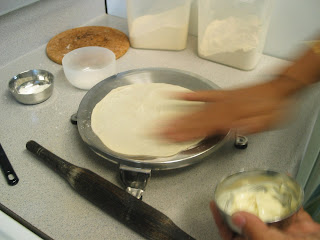Now onto the remaining part of my diwali faral...its late but these recipes are ones that can be enjoyed any time of the year. Enjoy!
Shev
 (Shev--- in the bowl on the left hand side of the plate
(Shev--- in the bowl on the left hand side of the plateChivda---in the center of the plate)
Ingredients:
5 cups Besan (Chickpea flour)
2 tbsp Oil
1/2 tsp Black peppercorns
1/2 tsp Cloves
1/4 tsp Ajwain seeds
2 tsp Cayenne pepper (adjust to your spice level)
Salt to taste
Water to make the dough
Shev press or Chakli press (sorya)
Oil to fry
Method:
Grind together the peppercorns, cloves and ajwain to a powder. In a bowl mix together the besan, oil, ground spice powder, cayenne pepper and salt. Now make a dough out of this mixture with some water. Taste it and adjust the spices. Cover and let rest for 1/2 an hour. Next, heat vegetable oil in a kadhai. Take a small ball of dough and pass it through the shev/chakli press directly into the kadhai. Fry the shev till it turns golden brown. Do not wait till it turns dark brown as it keeps cooking even when removed from the oil. Repeat the process till all the dough is used up.
Chivda
Ingredients: (the quantities are approximate and can be changed as per liking)
2lb Super thin poha (Flattened rice)
7-8 Green chillies chopped
6-7 Curry leaves
2-3 tbsp Dalia split
1/4 cup Dry coconut shavings (khobra)
1/4 cup Peanuts (can use roasted or unroasted, peeled or unpeeled)
2-3 tsp Cayenne pepper
3 tsp Sugar
1 tsp Citric Acid (optional)
For the tadka:
3-4 tbsp Oil
1/2 tsp Mohri (mustard seeds)
1/2 tsp Jeera (Cumin seeds)
1/2 tsp Hing powder
1 tsp Halad (Turmeric)
Method:
First get all the ingredients ready. Take a huge plate and empty the packet of pohe on it. Add salt and cayenne pepper to it. To make dry coconut shavings, just take a regular peeler and run along the edge of the coconut. Now in a big kadhai (use the biggest one you have, makes life easier), heat the oil. Once heated, fry the peanuts a little. Make sure you don't leave them in too long or else they will burn and taste bitter. Same goes for all other ingredients as well. Remove the fried peanuts and add them to the poha. Next fry the coconut shavings and add to the poha. Do the same thing with the dalia split. You can also add some cashews to the chivda. Next, add the mustard seeds, cumin seeds to the oil and let them pop. Then add the hing and turmeric powder. Next, throw in the chopped chillies and fry till they become crunchy. To this add the curry leaves and fry for a minute. Now pour this tadka over the pohe. Mix together.
Now the pohe can be chewy, so to make them crunchy, just transfer them to the kadhai and keep stirring them on very low heat till they become crunchy. You can dry roast the pohe before you make the tadka but I prefer doing it this way, because I tend to burn the pohe. Another easy way to get them crunchy is to put them under the broiler for a couple of minutes, once the chivda is ready. Make sure you keep checking on them and stir them to avoid burning. Once the chivda is ready and crunchy, let it cool completely and then add the sugar and citric acid to it. Mix well. Citric acid is not a traditional addition but my hubby likes the tang it lends to the chivda and so do I. Enjoy with a cup of tea or as a snack with some curds...yum!
















































